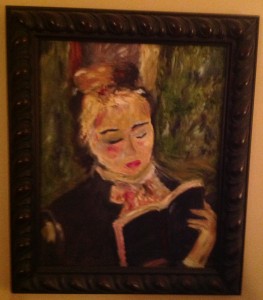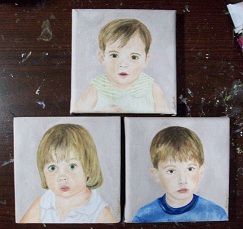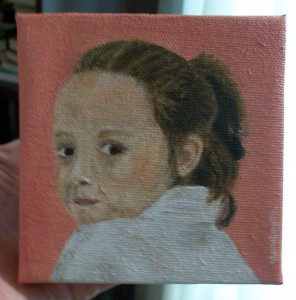By Minnie Lamberth
When Jay and Mary Ruth Wolf, our pastor and his wife, celebrated 20 years at the church, we were asked as a congregation to write cards so that they would receive an outpouring of love and appreciation in the form of these cards. Sounded logical enough, but I never could think of anything to write in a card.
I’m like that. I can write an essay, a radio spot, a speech, a memoir, or a set of stories about people I met in church. But when it comes to writing birthday or anniversary cards, that’s hard. I never got around to writing a card, but I am appreciative that they came 20 years ago. So I set about to see if, in lieu of the card I didn’t send, I could paint a small portrait of their grandson.
This was in my sixth month of trying a new thing. I was trying to paint mini-portraits of children that I called my Lambscapes. It’s a long story about why and how I was led to this idea, but painting mini-portraits of children is indeed what I was trying. My early subjects had been mostly family, or at the request of family. So how could I branch out and see where this would go? Here’s an idea: paint one for the pastor and his wife.
I looked through Mary Ruth’s Facebook photos to find the right image, and I saw one of their grandson, James, wearing a cap. Very cute. But I had never painted a cap before. For that matter, the size of this image was more suited to a 5”x5” canvas rather than the 4”x4” that I was usually doing. That meant the face was larger than I usually did. But what’s the harm in trying? If this didn’t work out, I could probably still go back and write that note I never wrote.
As I got into the painting process, I began to experience dismay. Working with this image was harder than I imagined it would be, and in the middle of it, I was sure that it would end as a disastrous experiment that needed to be carted out to the trash bin. First, I tried to paint the head without the cap (because of my unfamiliarity with caps) but that didn’t work because, having never met the child, I didn’t know his head well enough to know what it looked like without a cap. So I painted the cap on the head. Once I had done that, I could see that the contrast between cap and face was too great, and now James was looking sickly pale. Not good. Though I was hesitant to add more color to the face, wondering if I’d mess it up beyond repair, when I did, it looked better.
 In any case, I got to the point where I felt satisfied enough to let go, and I turned the painting over to Mary Ruth. I called this piece “Initial Cap” because, while it may not have been James’ first cap, it was certainly the first cap I ever painted.
In any case, I got to the point where I felt satisfied enough to let go, and I turned the painting over to Mary Ruth. I called this piece “Initial Cap” because, while it may not have been James’ first cap, it was certainly the first cap I ever painted. I had painted in lieu of sending notes once before, 14 years earlier. After my mother passed away in August 1997, my sisters, brother and I honored a principle that was important to her: we wrote our thank-you notes. For anyone who brought food or sent flowers or sent a contribution somewhere, we assigned the thank-you note to the sibling most associated with the sender. I maintained the spreadsheet of thank-you assignments, and we each wrote a lot of notes. But there were two I never got around to writing. I had been meaning to send notes to my friends Lynne and Kim. I met Lynne at First Baptist Church in 1989. I met Kim there too, during the same time period, when she visited with Lynne. Kim joined another church, but we kept being friends.
In any case, because these friends had been so sweet and supportive during those days of illness and grief, I meant to write a note. But I couldn’t come up with another way to say thank you. So I painted them each a painting. I had only learned about painting a few months earlier, during a class I’d taken that summer. Yet in my first Christmas season of grief, I brought those paints and canvases back out and worked on some things on my own and gave them to family members as well as a few friends.
Lynne’s painting had been a basket of flowers based on a sympathy card I’d received. But Kim’s was something different, something unusual. Sometime earlier, she had given me an 8×10 mounted print of a Renoir painting of a woman reading a book. When she had seen the print, Kim said, “I just liked her and wanted to get it for you. I don’t know why. I just did.” I didn’t know why she gave me that print either, but during that season of grief and giving away paintings in late 1997, that’s the subject I chose for Kim: I painted a 16×20 portrait of that woman reading a book.
Back to the more recent past – In February 2011, an idea was percolating, and I was getting sick. This was to be one of those two-week winter illnesses, but it came right at the time this idea was percolating.
“I don’t feel good,” I told my friend Jan at lunch. But I wasn’t making the connections about what those feelings meant and what I should do about them. So after lunch, I went to Hobby Lobby. I wanted to see if the store had anything that could help with this idea that was percolating, and indeed it did. I found a book on painting portraits of children. Still, by the time I got home, I had to go to bed. I was sick. This was a Tuesday. I was sick for a few days, I got better, then the next Monday, my sinuses felt like someone had opened up my head and inserted a brick.
Sadly, that week, Kim’s father passed away after an eight-year struggle with Alzheimer’s disease. In the middle of this struggle, Kim had moved back to her parents’ home in Selma to help her mother take care of her father, and now this end had come. That Monday night, Lynne and I rode over to see Kim and her mother.
A lot had happened around us and within us during the last 20 years. Looking back, I could see what Nehemiah might have seen when he evaluated the walls of Jerusalem that had broken down and saw the gates that needed repair. These things happen in all of our lives. We move away from where we intended to go. The wrong things come in through broken-down walls; good things inside gateless homes never get out. But once  Nehemiah leads his kin to rebuild the walls and gates of Jerusalem, Ezra comes and reads to the people from the Word of God. When they hear these words, they become very sad because they realize that they could have been a different kind of people.
Nehemiah leads his kin to rebuild the walls and gates of Jerusalem, Ezra comes and reads to the people from the Word of God. When they hear these words, they become very sad because they realize that they could have been a different kind of people.
 Nehemiah leads his kin to rebuild the walls and gates of Jerusalem, Ezra comes and reads to the people from the Word of God. When they hear these words, they become very sad because they realize that they could have been a different kind of people.
Nehemiah leads his kin to rebuild the walls and gates of Jerusalem, Ezra comes and reads to the people from the Word of God. When they hear these words, they become very sad because they realize that they could have been a different kind of people. That night, I was sad because Kim’s father had died after this long illness. I was sad because I was concentrating on my breathing too much to be of any use. And I was sad because I saw something I had missed. While at her house that night, Kim showed me her room, and in the room, I saw on the wall the painting I’d done 14 years earlier. “I did that?” I asked. How I did that, I do not remember other than I copied the master. But why didn’t I do more of that and could I do it now?
After the people in Nehemiah’s time hear the Word of God, they are very sad because they missed some things. But Nehemiah tells them, “Do not grieve, for the joy of the Lord is your strength.” What I might draw from that: there’s no magic to doing something 14 years earlier. If now is the time, do it now. So I went back home and tried to figure out how to paint mini-portraits of children. By the end of the year, Kim was my first best customer: she commissioned three for her brother for Christmas.

I had in mind that soon I’d do a Lambscape for Lynne. She had a banner birthday coming up, and this painting would provide a symmetry of sorts. Ten years earlier, Lynne had had a banner birthday, and as her gift, I had painted a small picture of a door – on a 4” x 5” canvas – with a note to the effect “You never know what’s beyond the door.” Happening across the small practice canvas I’d done for that painting of a door had influenced my thinking about painting, and about painting small pieces.
Now, ten years later, Lynne was on her way to another banner birthday, and obviously the way for me to tie these two intervals together from my perspective would be to paint a picture of her little girl, Laura.
That was another bit of symmetry. One reason that I had not pursued portraiture of any size is that I had been writing the novel manuscript that would become Life with Strings Attached. I started this draft 18 months after my mother passed away, worked on it for two or three years, then pursued an agent/publisher for two or three years. After I had nearly given up on anything ever happening with it, I submitted the manuscript to a contest being run by Paraclete Press seeking a literary novel with Christian themes.
At the same time, Lynne was moving toward her desire and call to adopt a little girl from Russia as a single mother, and the culmination of both of these events happened on the same day. On April 24, 2004 when Lynne arrived in Montgomery with little Laura, I was in Grand Rapids, Michigan, receiving the Paraclete Fiction Award, which would become my route to publication of this long-awaited novel.
 This idea of symmetry said: paint a Lambscape of Laura for Lynne’s birthday. The problem is, Laura smiles in every picture. She’s a smiler. Newly home from Russia: all smiles. Nine years of Auburn games, poolside, horse rides, karate, mermaid training… smiles, smiles, smiles. In Lambscapes, however, the children don’t typically smile. They stare off in space curiously. In any case, I looked through Lynne’s Facebook photos and settled on one that was Laura’s smallest smile, and I created the painting for Lynne’s birthday.
This idea of symmetry said: paint a Lambscape of Laura for Lynne’s birthday. The problem is, Laura smiles in every picture. She’s a smiler. Newly home from Russia: all smiles. Nine years of Auburn games, poolside, horse rides, karate, mermaid training… smiles, smiles, smiles. In Lambscapes, however, the children don’t typically smile. They stare off in space curiously. In any case, I looked through Lynne’s Facebook photos and settled on one that was Laura’s smallest smile, and I created the painting for Lynne’s birthday. Now Kim has a banner birthday coming up, so she’s getting one of these new things I’m doing. I’ve been toying with this idea of creating paintings that are cute and sweet based on an available image but not necessarily commissions of specific children. That way, they could go to anyone. For these projects, I settled on an image that I call “Bedtime Prayers.”
One recent day, I had shown an old friend various images of my Lambscapes, and during all of them, one by one, she had said, “sweet, precious…,” all those words like that. Then I got to this new image.
“Who is it?” she asked.
“Nobody, anybody.”
Her face was puzzled. “Who would want it if it’s not your child?” she asked.
Fair question, to be sure. But did Saturday Evening Post ask Norman Rockwell, “Who would want it if it’s not your child?”
 I shrugged. “I don’t know. It’s cute and sweet. People like things that are cute and sweet. So I’ll just try it and see what happens.”
I shrugged. “I don’t know. It’s cute and sweet. People like things that are cute and sweet. So I’ll just try it and see what happens.” Then she said, as old friends are wont to do, “Don’t listen to me. What do I know?” But I do listen, and one thing could be missing: that little painting might need a story. If it had a story, that might make a difference.
__________________
“On the Canvas with Children” is part of a continuing series by Minnie Lamberth called People I Met at Church. Originally posted January 2013 at www.minnielamberth.com.